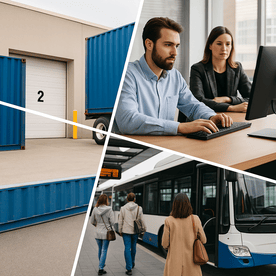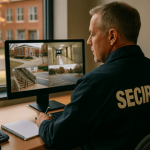
In 2025, transportation facilities are no longer just warehouses or terminals—they’re evolving into mixed-use environments where logistics operations, corporate offices, and even public amenities often share the same property.
While this model improves efficiency and space utilization, it also introduces a critical challenge:
How do you secure a facility that serves multiple functions, multiple user groups, and multiple risk profiles—all at once?
At SSP, we help transit authorities and logistics operators rethink depot security with a focus on zoned protection, coordinated access control, and layered surveillance strategies. Here’s how to protect these complex sites without slowing down operations—or leaving vulnerabilities unchecked.
k
k
What Is a Mixed-Use Transportation Depot?
A mixed-use depot is any transportation facility that houses more than one type of activity. For example:
-
A fleet yard with administrative offices on-site
-
A warehouse that shares space with public parking or retail pickup
-
A regional bus terminal with commercial leasing tenants
-
A distribution center that accommodates third-party logistics (3PLs) and vendors
These types of setups are becoming increasingly common—but traditional “one-size-fits-all” security systems often fail to account for the complexity.
k
k
The Challenge: One Property, Many Security Needs
Each zone within a mixed-use depot has different security requirements, depending on who uses it and what assets are present.
Here's a typical breakdown:
| Zone | Users | Primary Risks |
|---|---|---|
| Fleet Yard | Drivers, maintenance | Unauthorized entry, fuel theft, vehicle tampering |
| Logistics/Warehouse | Staff, 3PL partners | Cargo theft, staging tampering, loading dock risks |
| Offices/Admin | Employees, execs | Sensitive data exposure, internal threats |
| Public Access Areas | Visitors, customers | Loitering, access to restricted zones, safety liability |
Trying to apply a single access rule or surveillance system across these zones can leave your facility exposed—or frustrate the people working there every day.
k
k
Step 1: Implement Zone-Based Access Control
Rather than giving everyone a badge or PIN that works “everywhere,” SSP helps clients set up role-based access control, tied to specific zones and time windows.
For example:
-
Drivers can access only fueling stations and parking zones
-
Office staff can enter admin areas, but not loading docks
-
Vendors can access only delivery entrances during scheduled hours
-
Public guests are restricted to designated lobbies or waiting zones
This ensures each user can do their job—without gaining access to areas they shouldn’t.
Bonus: With mobile credentials and badge scanning, every access event is logged, making it easier to investigate issues or track movement throughout the site.
k
k
Step 2: Layer Your Surveillance Strategy
A single surveillance system might not cut it in a multi-use depot. You need camera placement, analytics, and alerting tailored to each area’s unique risks.
Here’s how we recommend layering it:
-
Warehouse Zones: High-resolution cameras with object detection to track pallet movement or vehicle loading
-
Fleet Yards: LPR (License Plate Recognition) for secure, automated gate access
-
Office Entrances: Facial recognition or card access integration with video footage
-
Public Areas: Smart motion detection and loitering alerts to identify suspicious behavior without staff intervention
When integrated into a centralized monitoring platform, this gives your team a real-time view of the entire facility—from fuel islands to conference rooms.
k
k
Step 3: Coordinate Emergency Communication Across Zones
In a facility serving multiple user groups, a single emergency event—like a fire, security breach, or active threat—can affect different zones in very different ways.
A smart emergency response plan includes:
-
Mass notification systems that can be customized by area (e.g., only alerting fleet and warehouse staff, not office personnel)
-
Panic buttons or intercoms that connect to a central response team
-
Automated lockdowns based on zone status and occupancy
SSP’s emergency communication integrations ensure that no zone is left out, and that responses are swift, coordinated, and visible.
k
k
Step 4: Design Security Around Workflow, Not Just Walls
A key insight we offer our clients:
Design your security systems around how people and goods actually move—not just the building layout.
This means:
-
Mapping typical delivery and pedestrian traffic
-
Understanding shift changes, vendor schedules, and idle zones
-
Reviewing where public access overlaps with private operations
This operational lens helps us spot vulnerabilities that aren’t always obvious from blueprints—like a back hallway used as a shortcut or a public restroom near a loading zone.
kk
k
Final Thoughts: One Facility, Many Front Doors
Mixed-use depots may be efficient—but they’re also complicated. The key to protecting them isn’t adding more security—it’s designing smarter, zone-based systems that support each function without creating bottlenecks.
At SSP, we bring together access control, surveillance, communication, and integration tools that help transportation facilities operate securely, seamlessly, and with confidence—no matter how many zones or user types they support.
Discover how SSP keeps transportation systems secure and operational.
Contact us today to schedule a mixed-use facility security consultation.


